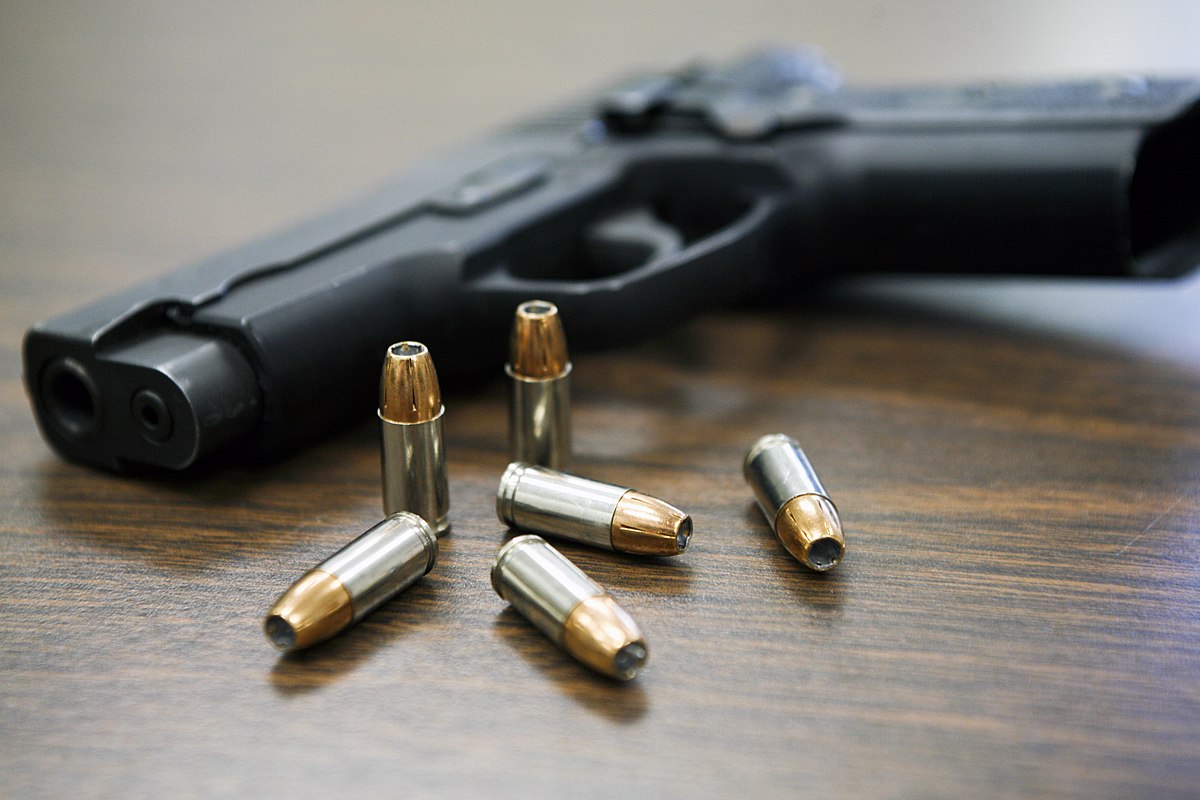Supreme Court hears arguments on constitutionality of domestic violence gun ban

A gun and some ammunition rest on a table. WIKIMEDIA COMMONS/St. Louis Circuit Attorney's Office
Nov. 12 (ZFJ) — The Supreme Court heard arguments on whether a federal ban on firearms possession by people under domestic violence restraining orders violates the Second Amendment in the case United States v. Rahimi (22-915) on Tuesday, Nov. 7.
The statute in question, 18 U.S.C. § 922(g)(8), prohibits people who are under a restraining order from possessing guns. The court order must include a finding that the person is a credible threat to an “intimate partner or child” or explicitly prohibit any physical force against them. It also must be issued following a court hearing that the person received notice of and could participate in.
The challenge to the ban was facial, or due to possible improper wording, as opposed to an as-applied challenge, which concerns how a law is enforced.
BACKGROUND
The defendant, Zackey Rahimi, had a history of participating in shootings and a hit-and-run between December 2020 and January 2021. He was placed under a civil protective order for alleged assault against his ex-girlfriend.
The order explicitly prohibited him from possessing guns. Police searched his home and found a rifle and pistol, so Rahimi was charged with violating the federal domestic violence gun ban.
Rahimi pleaded guilty but appealed on constitutional grounds. The 5th Circuit Court of Appeals agreed with his argument that the Supreme Court’s decision in New York State Rifle & Pistol Association Inc. v. Bruen (20-843) last year made the gun ban unconstitutional, so the court struck it down.
SOLICITOR GENERAL PRELOGAR’S ORAL ARGUMENT
In just over 90 minutes of oral argument, Solicitor General Elizabeth B. Prelogar represented the U.S. government, while Assistant Federal Public Defender J. Matthew Wright represented Rahimi.
Prelogar pushed back against the 5th Circuit’s conclusion, arguing that Bruen allows Congress to “disarm those who are not law-abiding, responsible citizens.”
“Throughout our nation’s history, legislatures have disarmed those who have committed serious criminal conduct or whose access to guns poses a danger, for example, loyalists, rebels, minors, individuals with mental illness, felons, and drug addicts,” Prelogar said in her opening statement.
The justices questioned her at length about her use of the term “responsible” and definition for it. Chief Justice John G. Roberts pointed out that not taking the recycling out on time or causing problems at a sports event are irresponsible behaviors.
Prelogar responded that she used the term “not responsible” because “it’s the standard that this Court itself has articulated” in prior cases. She also argued that the term encompasses people who could pose a danger with a gun without culpability.
“I think probably the reason the Court has used the term ‘not responsible’ is it gets at the idea that some of the categories of people who can be disarmed might not intend to be dangerous,” she explained. “They might not be culpable in that sense, like the mentally ill or minors, and so I think responsibility gets at the idea that they might not actually intend to be a danger but, in fact, would present a danger.”
We would be happy with a decision that says legislatures for time immemorial throughout American history have been able to disarm those who are dangerous.
— Solicitor General Elizabeth B. Prelogar, oral argument
She argued that domestic violence restraining orders require individualized findings of dangerousness and that defendants can challenge the adequacy of notice of the hearing or order itself through the state court system. Thus, she concluded, it is fair to prohibit such people from possessing guns.
Prelogar asserted that lower courts were misinterpreting the Bruen decision by striking down gun regulations on the basis that there were no similar laws on the books previously in U.S. history.
“I think that comes very close to requiring us to have a dead ringer when Bruen itself said that’s not necessary,” she told the Court. “The way constitutional interpretation usually proceeds is to use history and regulation to identify principles, the enduring principles that define the scope of the Second Amendment right.”
“We would be happy with a decision that says legislatures for time immemorial throughout American history have been able to disarm those who are dangerous,” Prelogar said in response to Justice Amy Coney Barrett’s questioning.
ASSISTANT FEDERAL PUBLIC DEFENDER WRIGHT’S ORAL ARGUMENT
Wright argued that a domestic violence order hearing is not sufficient to revoke “an individual’s fundamental right to keep arms,” saying that “there is no due process required before a court enters an order enjoining me from committing physical abuse against someone else.”
“They [Congress] made a one-sided proceeding that is short of a complete proxy for a total denial of a fundamental and individual constitutional right,” he said in his opening.
The justices were skeptical of this claim. Justice Neil Gorsuch pointed out that “there’s always process before a right or life, liberty, or property is taken from you of some kind.”
It’s the bootstrapping of what is a proceeding that is one-sided and does not have any kind of historical connection to the loss of citizenship rights.
— Assistant Federal Public Defender J. Matthew Wright, oral argument
Wright backed the 5th Circuit’s interpretation of Bruen requiring the government to find a similar law from “the historical tradition of firearms regulation” supporting someone’s disarmament.
“It’s the bootstrapping of what is a proceeding that is one-sided and does not have any kind of historical connection to the loss of citizenship rights, bootstrapping that as like a conclusive presumption to a right that the federal Constitution guarantees against Congress,” he said.
In response to the justices’ questioning, Wright conceded that the government should have the power to disarm individuals temporarily, but argued that it’d need a court finding “that nothing short of surrender of firearms would prevent damage to life and limb.”
SOLICITOR GENERAL PRELOGAR’S REBUTTAL ARGUMENT
Prelogar reiterated her concerns about the lower courts’ interpretations of Bruen. She pointed out cases where district courts have rejected disarmament of “armed career criminals” who’ve committed “aggravated assault, drug trafficking, armed robbery, clearly violent crimes” since “we don’t have a sufficient historical analogue disarming those subject to precisely those crimes at the Founding.” She said one court rejected a federal law prohibiting the possession of guns with removed serial numbers on the same basis.
“Once the Court corrects the misinterpretation of Bruen, then I think the constitutional principle is clear,” she said. “You can disarm dangerous persons.”
She cited data that a woman living in the same house as a domestic abuser who has a gun is five times more likely to be murdered and that domestic violence calls are the most dangerous for responding police officers.
“It [the ban] does guard against a profound harm,” she concluded. “Congress can disarm armed domestic abusers in light of those profound concerns.”
The Supreme Court will issue its decision before late June, when its term ends.
References
- Legal Information Institute, Cornell Law School - 18 U.S. Code § 922 - Unlawful acts - https://www.law.cornell.edu/uscode/text/18/922 (ARCHIVE)
- Oyez - United States v. Rahimi - https://www.oyez.org/cases/2023/22-915 (ARCHIVE)
- U.S. Supreme Court - Question Presented Report 22-915 UNITED STATES V. RAHIMI - https://www.supremecourt.gov/qp/22-00915qp.pdf (ARCHIVE)
- U.S. Supreme Court - Oral Argument Transcript 22-915 UNITED STATES V. RAHIMI - https://www.supremecourt.gov/oral_arguments/argument_transcripts/2023/22-915_986b.pdf (ARCHIVE)
- U.S. Supreme Court - Oral Argument Audio 22-915 UNITED STATES V. RAHIMI - https://www.supremecourt.gov/oral_arguments/audio/2023/22-915 (ARCHIVE)
